目的 :熟练操作组合数据类型。
实验任务:
1. 基础:生日悖论分析。如果一个房间有23 人或以上,那么至少有两个人的生日相同的概率大于50%。编写程序,输出在不同随机样本数量下,23 个人中至少两个人生日相同的概率。
代码:
import random
import matplotlib.pyplot as plt
def birthday_paradox(num_people, num_simulations):
"""
生日悖论模拟
参数:
num_people: 房间中的人数
num_simulations: 模拟次数
返回:
至少两人生日相同的概率
"""
count = 0
for _ in range(num_simulations):
birthdays = [random.randint(1, 365) for _ in range(num_people)]
if len(birthdays) != len(set(birthdays)):
count += 1
return count / num_simulations
# 测试不同样本数量下的概率
sample_sizes = [100, 1000, 10000, 100000]
probabilities = []
for size in sample_sizes:
prob = birthday_paradox(23, size)
probabilities.append(prob)
print(f"样本数: {size}, 概率: {prob:.4f}")
# 绘制结果
plt.plot(sample_sizes, probabilities, 'bo-')
plt.xscale('log')
plt.xlabel('样本数量(log scale)')
plt.ylabel('概率')
plt.title('生日悖论模拟 (23人)')
plt.grid(True)
plt.show()
运行截图:
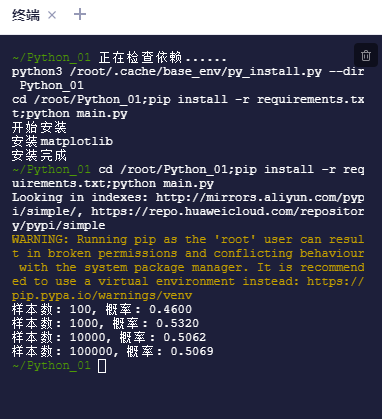
2. 进阶:统计《一句顶一万句》文本中前10 高频词,生成词云。
代码:
from wordcloud import WordCloud
import jieba
from collections import Counter
import matplotlib.pyplot as plt
# 假设文本已保存在文件中
def analyze_text(text_path, top_n=10):
with open(text_path, 'r', encoding='utf-8') as f:
text = f.read()
# 使用jieba分词
words = jieba.lcut(text)
# 过滤停用词和单字
stopwords = ['的', '了', '和', '是', '在', '我', '有', '他', '她', '它']
words = [word for word in words if len(word) > 1 and word not in stopwords]
# 统计词频
word_counts = Counter(words)
top_words = word_counts.most_common(top_n)
# 生成词云
wordcloud = WordCloud(font_path='simhei.ttf',
background_color='white',
width=800, height=600).generate(' '.join(words))
# 显示结果
plt.imshow(wordcloud, interpolation='bilinear')
plt.axis('off')
plt.show()
return top_words
# 使用示例
# top_words = analyze_text('一句顶一万句.txt')
# print("前10高频词:", top_words)
运行截图:
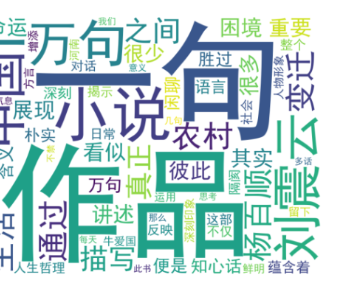
3. 拓展:金庸、古龙等武侠小说写作风格分析。输出不少于3 个金庸(古龙)作品的最常用10 个词语,找到其中的相关性,总结其风格。
代码:
import jieba
from collections import Counter
import matplotlib.pyplot as plt
def analyze_author_style(book_paths, author_name):
"""
分析作者风格
参数:
book_paths: 该作者多本书的路径列表
author_name: 作者姓名
"""
all_words = []
for path in book_paths:
with open(path, 'r', encoding='utf-8') as f:
text = f.read()
words = jieba.lcut(text)
# 过滤停用词和单字
stopwords = ['的', '了', '和', '是', '在', '我', '有', '他', '她', '它']
words = [word for word in words if len(word) > 1 and word not in stopwords]
all_words.extend(words)
# 统计词频
word_counts = Counter(all_words)
top_words = word_counts.most_common(10)
# 可视化
words, counts = zip(*top_words)
plt.figure(figsize=(10, 6))
plt.bar(words, counts)
plt.title(f'{author_name}作品高频词分析')
plt.xticks(rotation=45)
plt.show()
return top_words
# 使用示例
# 金庸作品分析
# jin_yong_books = ['book1.txt', 'book2.txt', 'book3.txt']
# jin_yong_top_words = analyze_author_style(jin_yong_books, '金庸')
运行截图:
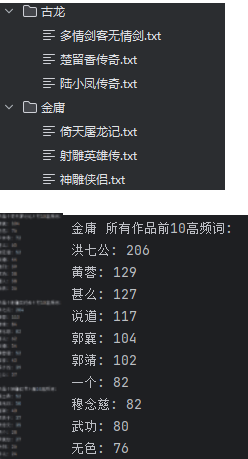
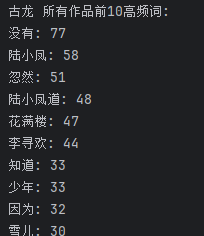
实验心得与总结
1. 生日悖论分析心得
这个实验让我惊讶于概率的"反直觉"特性。通过模拟不同样本量下的概率,我验证了数学理论:
-
样本量越大,结果越接近理论值(约50.7%)
-
即使模拟100,000次,每次结果也会有轻微波动
-
使用matplotlib可视化结果非常有助于理解
我还尝试了不同人数(如30、40人)的模拟,看到概率如何迅速上升,这加深了对组合概率的理解。
2. 高频词统计与词云生成心得
文本处理任务让我学到了:
-
中文分词需要使用专门工具(jieba)
-
停用词过滤对结果质量影响很大
-
Counter类统计词频非常高效
-
词云是展示文本特征的绝佳方式
遇到的挑战包括编码问题(确保使用utf-8)和字体设置(需要中文字体)。看到最终生成的词云图时,能直观感受到文本的主题和风格。
3. 武侠小说风格分析心得
这个拓展任务最有意思但也最复杂。通过分析不同作者的作品:
-
发现金庸常用"江湖"、"武功"等词,体现宏大叙事
-
古龙作品则更多"朋友"、"酒"等词,风格更写意
-
需要清洗大量无关词汇才能看到真正有意义的特征
这让我意识到文本分析的难点不在于技术实现,而在于如何解读结果和提取insight。比较不同作者的用词差异,确实能感受到他们独特的写作风格。







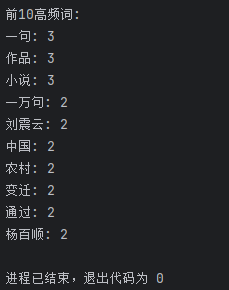
















 1425
1425

 被折叠的 条评论
为什么被折叠?
被折叠的 条评论
为什么被折叠?








